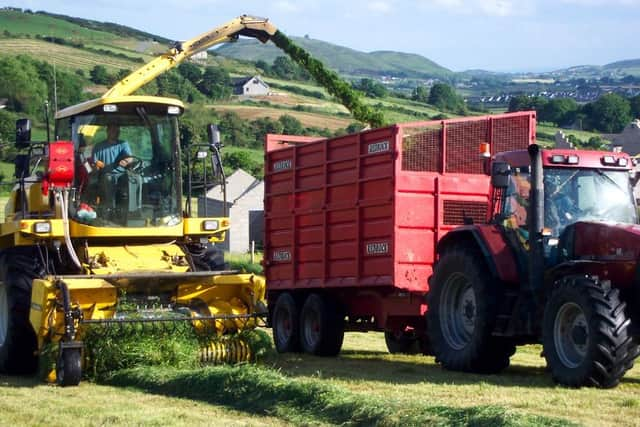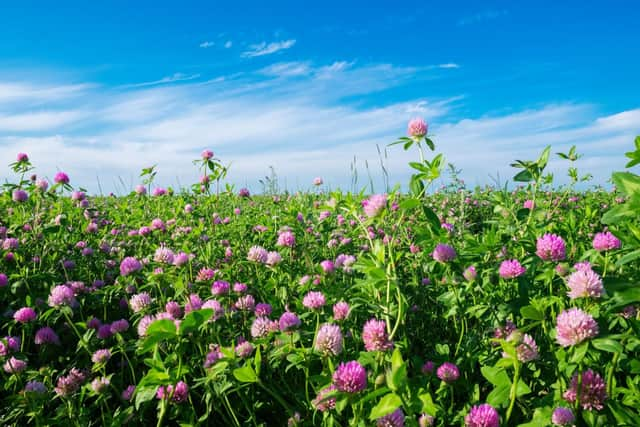Red clover can act to deliver improved silage quality
and live on Freeview channel 276
The event was hosted under the auspices of the ongoing ZeroNSile project in Northern
Ireland.
Courtesy of his opening comments AgriSearch general manager, Jason Rankin, highlighted the key role that high quality silages play within all ruminant production systems.
Advertisement
Advertisement


He added that recent years had seen increased costs and greater volatility, where the price of chemical fertilisers is concerned.
“Fertiliser use accounts for approximately 20% of greenhouse gas production on farms across Northern Ireland,” he commented.
“Significantly, trials carried out by Agri-Food and Biosciences’ Institute scientists have confirmed that red clover based swards can deliver high yields and equally high levels of protein without the use of chemical nitrogen.
“However, there has been a low uptake of this production option up to now.”
Advertisement
Advertisement


The ZeroNSile project has seen red clover swards established on 11 farms over the last 12 months.
According to Rankin, 2024 will be the first year in which intensive monitoring of the swards will take place.
He continued: “A smaller scale lucerne project has also been established on three farms in Co Down.”
According to the AgriSearch representative, red clover varieties have the potential to fix 200kg/ha of nitrogen (N) from the atmosphere on an annual basis.
Advertisement
Advertisement
Trial work carried out by AFBI has confirmed that pure stands of red clover can produce up to 13t of dry matter (DM)/ha/annum.
“As a consequence, farmers growing silage swards containing significant quantities of red clover need only add the required levels of potash and phosphate to ensure that high levels of productivity are secured,” Rankin continued.
“In addition, the protein in red clover is of an exceptionally high quality. This then allows livestock farmers to reduce the levels of additional protein they offer stock in concentrate feeds.”
However, Rankin is also acknowledging that red clover is a complicated crop to grow.
Advertisement
Advertisement
“Soil pH, phosphate and potash levels must be correct in order to optimise crop growth,” he explained.
“Red clover grows from a single point within the plant. If this crown is damaged, issues relating to persistency within a silage sward will arise.”
As a general rule of thumb, it is now envisaged that red clover will persist within silage swards for a maximum of four years.
“It is generally recommended that a mix of red clover, white clover and perennial ryegrass should form the main constituents of a 10-year silage sward,” Jason Rankin further explained.
Advertisement
Advertisement
“The red clover will generate its impact during the first four years, post-establishment.
"Thereafter, the ryegrass and white clover can maintain the high levels of output and forage quality until such times as the ground is re-seeded again.”
Establishing red clover swards
The webinar also provided an overview of how best to establish productive red clover swards.
But why should farmers opt to grow red clover swards in the first place?
Advertisement
Advertisement
This was the first question addressed Dr David Patterson, courtesy of his presentation.
Patterson is a grassland agronomist at with the Agri-Food and Biosciences’ Institute (AFBI).
He is based at the organisation’s research centre, near Hillsborough in Co Down.
He explained: “Red clover can fix up to 200kg of nitrogen per hectare from the air on an annual basis. Crops have the potential to produce up to 15t of dry matter per hectare, again on a dry matter basis.
Advertisement
Advertisement
“High animal intakes and comparable levels of animal performance can be achieved while the growth profile of red clover will act to improve soil structure.
"This level of clover output is achieved on the back of up to four silage cuts in the same season.”
Patterson continued:
“The downsides associated with red clover include its lack of persistency.
"It can be difficult to ensile, crops are problematic form a grazing perspective and a four-year break is needed between crops of red clover that are established in the same field.
Advertisement
Advertisement
“Four years is the optimal period over which a red clover sward will deliver productive yields After that it is a case of moving on to new ground.
“Crops of the legume can also be predisposed to clover rot and stem eel worm.
"Hence the requirement for a four-year break when it comes to establishing red clover in the same location.”
According to Patterson, all previous vegetation in a field must be killed-off with a herbicide prior to the establishment of a new, red clover sward.
Advertisement
Advertisement
“This is the only way that the new crop will get the chance it requires,” Patterson explained.
“After that, any tradition cultivation system can be used. These include ploughing, discing or power harrowing or any combination of these.
“The objective is to create a fine, firm seed bed. It’s a table top finish that growers should be aiming for."
He continued: “Stale seed beds are an option as a means of reducing weed numbers, once the new sward is sown out.
Advertisement
Advertisement
“Red clover is not really suited to over seeding-based establishment systems relative to what is the case for white clover seed.
“Rolling prior to and after planting is advised with red clover swards.
"Seeds should be placed at depths between 5 and 10mm.
"It is important for the seed to stay in or around the surface of the soil
“Red clover seeds are the three times the size as those produced by white clover.”
Advertisement
Advertisement
The AFBI scientist confirmed that red clover swards are best established when soil temperatures are around 8 °C.
This takes in the period late April through to early June.
The advised seeding rate is 6kg/ac for stands of pure red clover or a blend of 9kg of a companion grass and 4kg of red clover when a mixed swards is required.
The optimal soil pH value for red clover establishment is 6.5.
Only phosphate and potash fertilisers are required at time of sowing.
Managing red clover swards
Advertisement
Advertisement
Red clover has the potential of fixing up to 250 kg of nitrogen per hectare from the air on an annual basis.
This figure is based on swards containing up to 5t of clover dry matter per hectare.
Moreover, the nitrogen fixed from the atmosphere is translocated throughout the growing season to the soil, where it is available to all the plants making up the sward.
David Patterson, discussed the best ways to manage red clover swards courtesy of his presentation to the recent AgriSearch webinar.
Advertisement
Advertisement
Specifically, he confirmed that clover will not fix atmospheric nitrogen at all if soil pH values are below 5.0.
Patterson added:
“Current research is pointing to a soil pH value of 7.0 being optimal when it comes to optimising clovers’ ability to take nitrogen in from the atmosphere."
According to Patterson, weed control is critically important when it comes to establishing and managing red clover swards.
He commented: “Weeds can be an issue in the early phases of red clover establishment, particularly if there is a carryover of docks and chickweed from the previous crop.
Advertisement
Advertisement
“The ideal scenario is to have the ground well and truly cleaned prior to sowing.
"A dock-infested grass filed, for example, is not the best starting point form which to establish any kind of red clover sward.
“There is a real limitation on the suitability of post-emergence herbicides.
"The bottom line is that any product used must be red clover safe.”
Advertisement
Advertisement
The AFBI agronomist confirmed that, assuming an effective post emergent herbicide becomes available in 2024, it should be used between 6 and 8 weeks after the new crop has been sown out.
He further explained:
“The majority of the clover plants must be at the trifoliate leaf stage with docks at a small enough size to be dealt with efficiently.
“Spraying too early will kill clover seedlings: spraying too late means that the canopy has closed over and, as a result, a high percentage of the target weeds have protection.”
Where the management of chickweed is concerned, effective control can be secured by grazing newly established swards with sheep or calves.
"But this must be for a short period of time only.
Advertisement
Advertisement
“Spot spraying of weeds is also feasible in certain circumstances,” said Patterson.
“Another option is to take a very early cut of silage, which will remove a lot of the competition pressure caused by the likes of chickweed.”
Red clover: a farmer’s perspective:
Meanwhile South Co Antrim suckler beef farm Alastair McNeilly has been trialling the use of red clover: perennial ryegrass in a silage making context for the past number of years.
And he is extremely excited with the results achieved to date.
Advertisement
Advertisement
“The swards are generating an average output of 13t of DM/ha. Last year it was clover area was cut four times and then grazed thereafter.
“We did not go in with a tedder after mowing,” Alastair stressed.
“The cut forage was allowed to wilt for 24 hours and then baled.
"I have tried to ensure that the clover has been allowed to flower least once, both in 2021 and again this year.
Advertisement
Advertisement
“No doubt, the clover will start to die back over the next year or so.
"But the scope to use more of it on this farm is obvious.
“I have also found that a mixed clover: ryegrass sward is very responsive to added slurry.”
But the proof of the pudding is always in the eating.
“During the middle of the 2022 drought, I had no option but to feed the clover bales to the bullocks that had been housed due to a shortage of grazed grass across the farm at that time,” Alastair explained.
“It was rocket fuel. The cattle were fed the mixed clover: grass silage plus 2kg of meal per head per day.
Advertisement
Advertisement
“They managed to achieve 1.2kg of liveweight gain on a daily basis.”
Looking ahead, Alastair is very conscious of the fast increasing costs impacting on every farm business at the present time.
He concluded:
“The scope to make more efficient use of slurry is considerable.
"Making more use of red clover is an option that I want to explore for the future.
Advertisement
Advertisement
“But the bottom line will always be that of making best use of the grass that grows on the farm: it will always be our cheapest and most valuable asset.”
About:
AgriSearch was formed in 1997 to provide a mechanism through which beef, dairy and sheep farmers could have direct involvement in production orientated research. Funds contributed to AgriSearch are used to commission research into the improvement and development of beef, sheep and dairy farming.
AgriSearch’s guiding principal is to provide practical benefit for primary producers to reduce costs, improve performance, drive innovation and improve welfare. Duplication of existing R&D work is avoided and every effort is made to get maximum leverage from complementary funding sources.
On Wednesday 28th February at 8pm, over 120 people attended the “Red Clover Establishment” webinar, hosted by AgriSearch. The webinar was held as part of the ZeroNsile project which has established red clover swards on 12 farms across NI and Lucerne on three farms in County Down.
Advertisement
Advertisement
The GrassCheck project aims to provide high quality, up-to-date grass information to assist farmers with grassland management decisions and support improvements in grass utilisation on Northern Ireland (N.I.) livestock farms is due to commence next week.